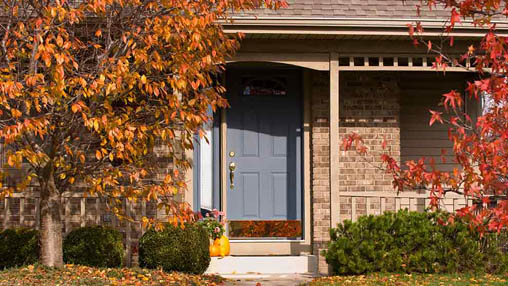
Earn cash back
after close!
With Home Connect, you could earn $350 to $9,500 cash back after close.
On the most basic level, an easement allows non-owners to legally access a specific property for a particular reason. As a homeowner, the idea of other people entering your land may be off-putting, but in practice, easements cause few problems and are relatively commonplace.
If you have ever purchased property, it’s quite possible that you have been involved in an easement and may not have known it. For example, many subdivision plans include easements that are deemed necessary for utility work, such as water/gas pipe access or electrical line maintenance, that are required by local zoning ordinances.
You probably shouldn’t let an existing easement dissuade you from buying a property without first understanding how it affects said property. With that in mind, we’ll discuss how easements work, why they are granted, and what your rights and options are on both sides. First, let’s take a look at the definition of an easement, so we understand the broader context.
What Is an Easement?
An easement is formally defined as the legal right of way granted to specifically designated individuals (or, in some cases, companies) to access or use land that they do not own for a particular, specified use.
As a property owner, here are two basic ways that easements may impact your property:
- If your property contains an easement held by outside parties, then those parties are legally allowed to access or use your property within the specific guidelines that were set during the creation of the easement. Utility easements are a widespread example of this, giving utility companies the ability to access drainage, sewer, or power lines on your property without your explicit permission.
- If you are the holder of an easement, you are allowed to use or access a portion of the property that you don’t actually own. A common example of this sort of easement is when your driveway must cross another person’s property in order to access the nearest road.
At first glance, easements may sound problematic and intrusive, but most homeowners don’t have easement issues, provided that proper research is done when buying or selling a property. Below you will learn everything you need to know in order to successfully own (or use) an easement.
Easement Rights on Both Sides
If your property contains an easement, or your new home comes with an easement to local property owned by others, you need to know what you can and can’t do—and what can and can’t be done with your property. In general, homeowners with an easement (the owner of the “servient land”) may use their property in any way that does not prevent the easement holder from using their easement. For example, if your waterfront home includes an easement for your neighbor to access the beach, you can’t fence off the beach on your property.
Conversely, if you are the easement-holding neighbor across the street from the waterfront home, you are considered the dominant land, and are allowed to use and enjoy the beach access that your easement grants you, as long as you don’t place an “unreasonable burden” on the servient land. When you hold an easement, you don't have the right to formally occupy the easement land, and you can’t prevent others from using it unless they are interfering with your own use. So, you can’t build your own gate blocking the beach path, but you do have recourse if someone else does.
How Are Easements Created?
The most common type of easements created are express easements and easements by necessity. Express easements are typically planned in advance, and created by being documented in a deed, or another printed document like a will, HOA information, or even a contract. It requires the same process as buying, selling, dividing, or creating any other type of interest in a piece of land: a written document, signatures from all involved, and the delivery of the final document.
Easements by necessity are created when a need arises, such as when a piece of land is subdivided and sold in lots with no access to a road. Those landlocked lots would be nearly impossible to use without the road access that an easement by necessity can grant. Occasionally, courts or individuals can create easements based on other special circumstances, including the types explained below.
7 Common Types of Easements
Utility easements are common and easy to understand, but there are many other types of easements, some of which can be fairly complex. Here are seven common types of easements, and specific tips and rules surrounding each one.
1) Easement in Gross
An easement in gross allows a person or a company to use the servient land for access or projects, such as the beach example above, or for roads or rail lines to cross property. Personal easements in gross can’t always be inherited, but commercial easements in gross can be transferred.
2) Easement Appurtenant
An easement appurtenant allows property owners to access their land that is only accessible through a neighbor’s land. This type of easement generally transfers with the dominant land, as it would be almost worthless without it.
3) Easement by Necessity
Similar to appurtenant easements, easements by necessity are exactly what they sound like: access to someone else’s property for a legitimate purpose. One common example where easement by necessity occurs is when one property is landlocked another and needs access to the public road.
4) Driveway Easement
Again similar to easements appurtenant and easements by necessity, driveway easements are also known as an easement of access. If your home does not border a road, easement through someone else’s property may be necessary for your driveway. In addition, some homes have shared driveways or walkways that can be allowed via easements, and should be documented in the deed to your property.
5) Utility Easement
One of the most common types, these easements give utility companies the ability to complete repairs and other projects on the parts of their systems that are on your property. Utility easements can include storm drain easements, sewer easements, and electrical and gas line easements.
6) Conservation Easement
Conservation easements are an agreement between the government and the land owner that give rights to a land trust that limits development. This is done to protect the environment, wildlife, and even water quality in a natural area. These type of easements tend to transfer with the land when it is sold.
7) Prescriptive Easement
A dominant landowner can acquire an easement over servient land without a written document: By openly and continuously using the servient property over a legally set period of time, they can gain what is called a prescriptive easement. More common in rural areas, creating a driveway or walking path, or by parking cars at the edge of a property can all lead to a potential prescriptive easement. In addition, the dominant user does not have to be the only one using the potential prescriptive easement.
If someone is using a part of your property, and you don’t mind—but also want to avoid a potential prescriptive easement—you may grant them written permission to do so. Providing permission prevents the possibility of a prescriptive easement claim, both now and in the future.
Can Easements Be Transferred or Terminated?
If your property contains one of the easement types mentioned above, will it be there forever? Most easements transfer with the dominant land, or easement holder, even if they are not specifically mentioned in the property sale documents. If the easement for some reason does not transfer with the sale of the property, it must be specified in the sale documents. Easements are generally created with an intention of being permanent, but property owners should still specify this.
An easement can be ended if you no longer need or want it. Easements can be terminated for a number of reasons, here are a few common ones:
- Release: Both parties agree to end the easement, typically in writing.
- Expiration: The easement reaches a planned expiration date, such as the completion of a construction project.
- Merger: When one property owner ends up owning both the dominant and servient land, the easement is no longer needed for one to access the other.
- Necessity: If the necessity that created an easement no longer exists, the easement can be terminated. This can be due to an expiration, merger, or other circumstances.
How Do Easements Affect My Property Value?
Overall, easements typically have little impact on your property value. They are relatively common, and most homes have them, even if they’re just for utilities. Even if your home contains, for example, an easement for your neighbor’s driveway or road, this will most likely not impact your property’s use and value. Do consider the size of the easement relative to your overall property size—a large easement on a small lot may have a bigger impact than a small easement on a very large lot.
In addition, if the type of easement your home holds (or is subject to) is common and well known in your area (such as all waterfront homes on a public beach), it should not change your home value, as your neighbors are all equally impacted.
As a prospective homebuyer, you can prevent future surprises by being sure that you understand the way that land is used and shared in the area of your possible new home. It’s also important to know if current easements can be transferred to you and your potential new neighbors when properties sell. Once you’ve started the homebuying process, your best source of answers to easement questions on specific properties is your real estate agent.
If you do decide to use a real estate agent, we recommend vetting those in your area. Find out what to ask when evaluating different agents.
It’s also important to keep in mind that property owners can sell easements, such as for a road, utility access, or even solar access. When looking at homes, make sure that your title company checks the title for documentation of any private easements that have been sold in the past. Many of these easements are obvious or harmless, but some can greatly impact the way that you can build or use your property. Limitations like this can have a significant impact on both your lifestyle and home value.
Rest Easy With Your Easement
When shopping for a new home, you have many potential problems to worry about, from inspection findings to negotiations. Easements on or owned by your property should not be one of those sources of stress: With a little research, easements can be easily understood and managed, both now and in the future. If you are ready to make your homebuying dreams a reality, apply using our online application or contact a loan officer to get your Pennymac pre-approval.
Share
Categories





